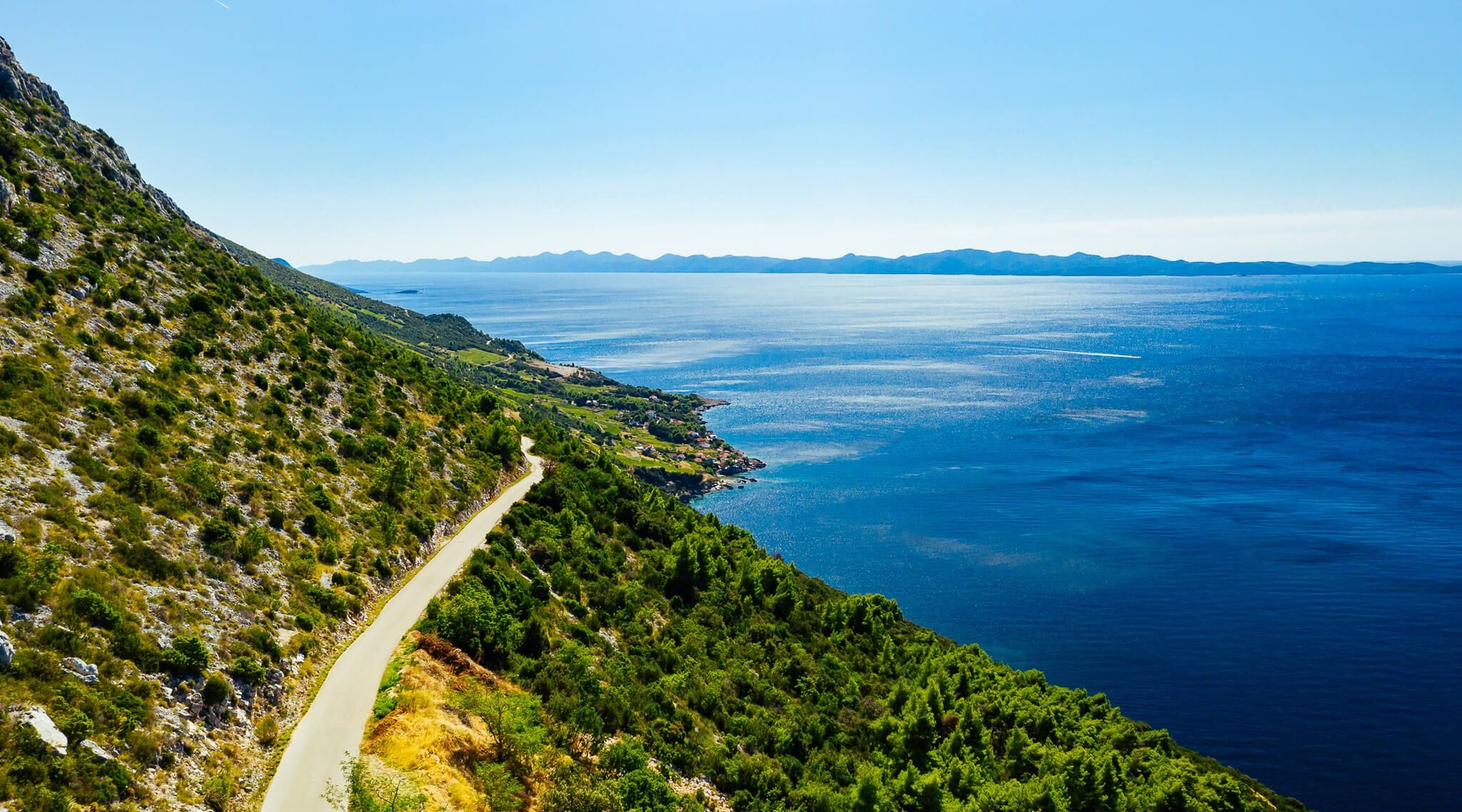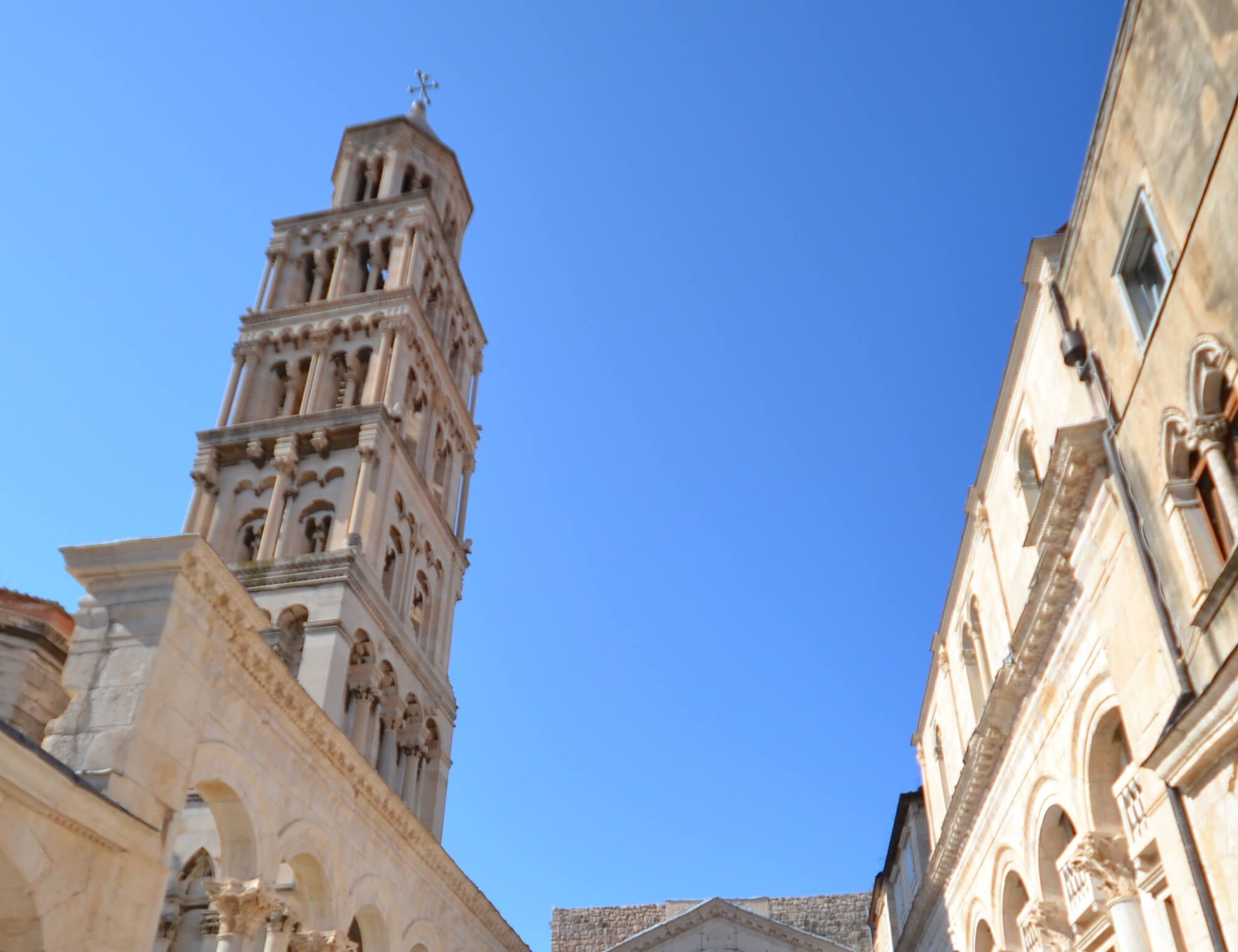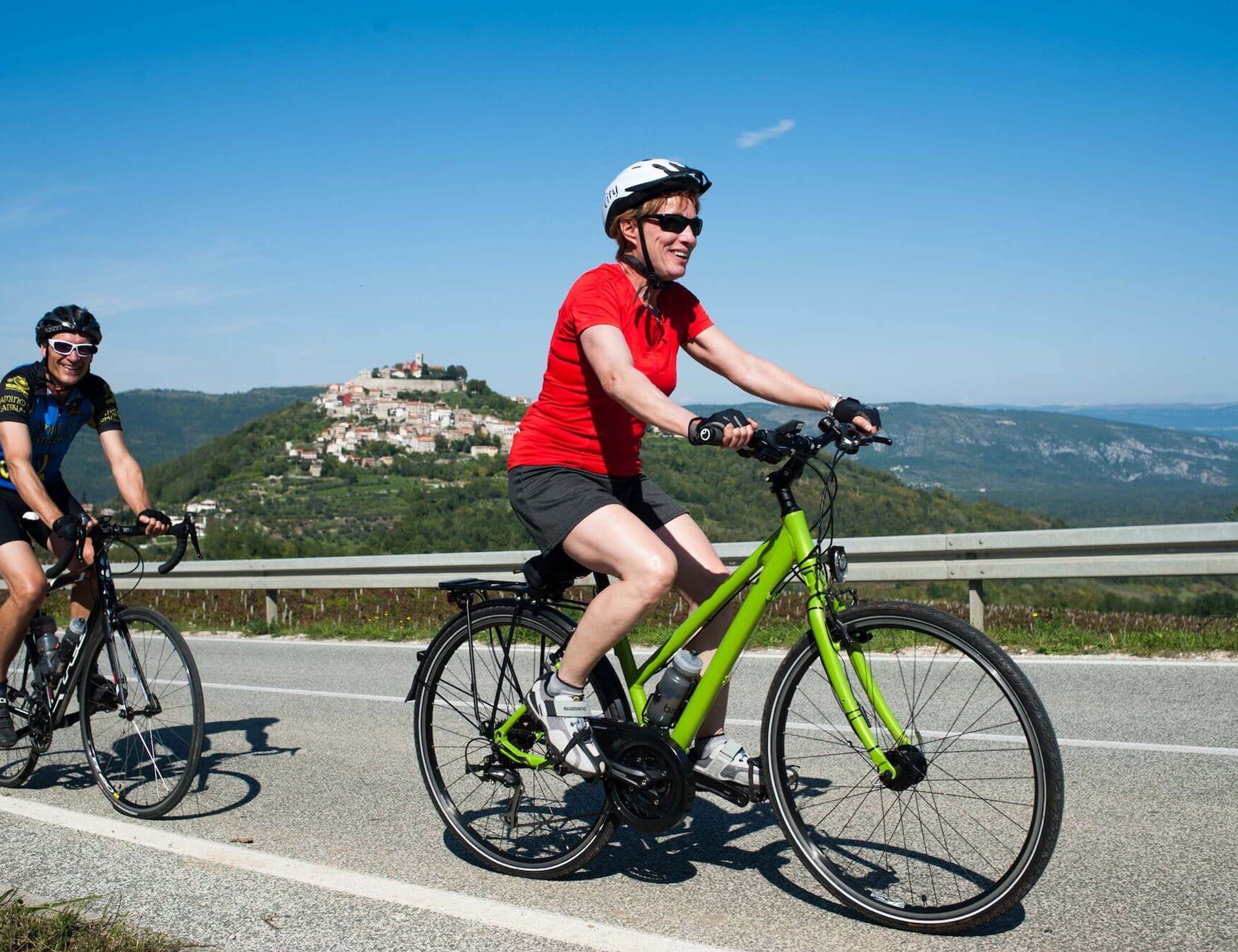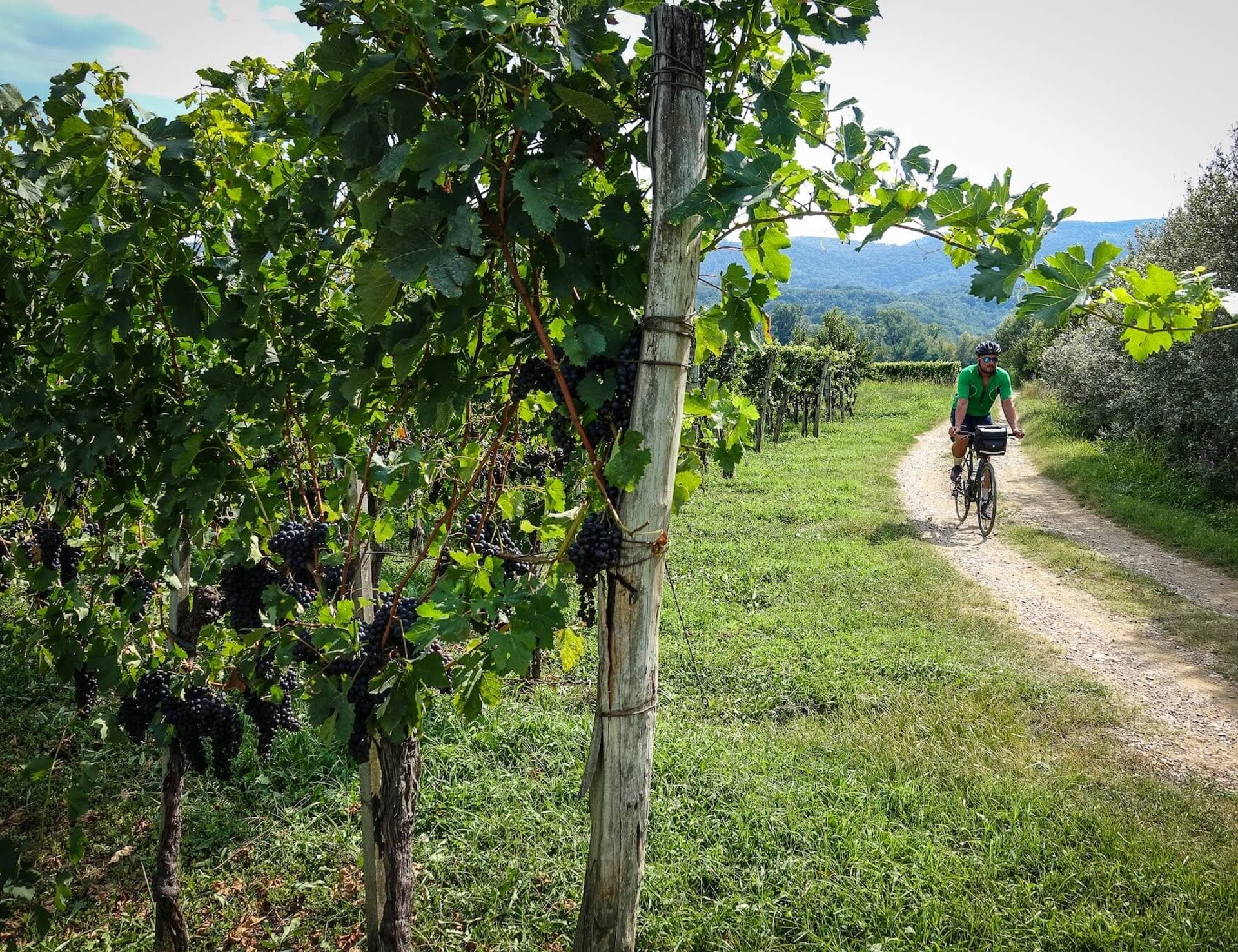
Cycling guides | Last updated:
The Complete Guide to Cycling Croatia
By Kamalpreet Singh •
Table of Contents
- 1. Understanding Croatia
- 2. Why Go Cycling Croatia?
- 3. What are the Best Places to Cycle in Croatia?
- 4. What are the Best Cycling Routes in Croatia?
- 5. When is the Best Time to Cycle Croatia?
- 6. Enjoying Croatian Cuisine
- 7. Croatia Visa Requirements
- 8. Handy Info
- 9. Through the Notes
- 10. Embrace the Bike Tour in Croatia
Understanding Croatia
Topography
Croatia is a country in southeastern Europe situated between 42° and 47° N latitudes and 13° and 20° E longitudes. It has a long coastline along the Adriatic Sea, which itself is the northernmost arm of the Mediterranean Sea.
Croatia has two distinct topological regions — the Adriatic basin with flat lowlands dominating the landscape, and the Dinaric Alps, with peaks ranging from 1100 to 1831 m above sea level. Mt Dinara (1831 m) is the highest peak in Croatia.
Karst topography, composed of limestone rocks forms a large part of Croatia’s landscape. The result is thousands of caves, canyons, and underground habitats.
Croatia has the most indented coastline in the Mediterranean, with over 78 islands scattered along its Adriatic coast.
Flora and Fauna
Nearly 44% of Croatia’s land area is covered under forests. Alpine forests cover the Dinaric Alps, while deciduous forests dominate the plains.
Animals commonly found in Croatia include the brown bear, Eurasian lynx, and the gray wolf. The European pine marten is Croatia’s national animal.
The famous Dalmatian breed of pet dogs originated in the Dalmatia region of Croatia as a hunting dog.
Olive trees are a prominent part of the landscape in Croatian islands, especially Brač and Korčula, while fields of lavender are commonly found on the island of Hvar. The Istrian peninsula of Croatia is famous for its high-quality black truffles.
Climate
Most of Croatia has a Mediterranean climate moderated by the Adriatic Sea. The islands of Hvar and Korčula receive over 2700 hours of sunshine per year.
The average temperature range for most of Croatia varies from −3 °C (27 °F) in January to 18 °C (64 °F) in July. Regions in the Dinaric Alps have an alpine climate. The mountains also receive heavy rainfall of up to 3500 mm per year.
Economy
Croatia has a highly developed economy dominated by the services sector. In 2023, the average Croatian earned $20,000 a year.
Tourism is the largest sector of Croatia’s economy, accounting for over 20% of its GDP. Most of Croatia’s tourism is centered around its beaches. Croatia has over 99 Blue Flag beaches, certifying its commitment to responsible, safe, and environmentally sustainable tourism.
Retail, agriculture, and energy are other important sectors of the Croatian economy.
DREAMING OF CYCLING IN CROATIA?
Explore our amazing bike tours in Croatia now!
Why Go Cycling Croatia?
Here are 6 great reasons to consider Croatia for cycling:
-
Island Hopping - When cycling Croatia’s Dalmatian coast, riders can have the unique experience of biking through one island, then loading their bikes onto a ferry, and moving on to explore the next island. In fact, on our Croatia bike tours, we explore the islands of Hvar, Brač and Korčula in this manner.
-
Great Weather Almost All Year Round - Croatia has a mild, Mediterranean climate with plenty of sunshine for most of the year, making it excellent for cycling. The cycling season begins in late spring and continues till late fall. Croatia cycling tours are all about sun, sand, surf, wine, and the sweet-smelling scent of mountainsides covered with pine.
-
The Best Beaches - The serene waters of the Adriatic Sea are known for their dramatic shades of blue and green that make it look like a Turkish mosaic. Croatia’s stunning Dalmatian coast, carved out of pine-covered mountains of karst, is known for having some of the most beautiful beaches in Europe. All our Croatia cycling tours are designed keeping the Adriatic and its beautiful beaches as the centerpiece.
-
Wines, Olives, and Truffles - Besides its beautiful beaches, Croatia is also famous for its wines, vineyards, and olive groves that make up much of its landscape. However, Croatia’s best kept secret are its truffles. Rivaling even the most expensive varieties found in Italy, Croatian truffles are the pride of gourmet chefs in Michelin star kitchens around the world. In Croatia, however, you get the once-in-a-lifetime chance to taste these delicacies fresh out of its forests.
-
Medieval Castles - Castles may be aplenty in Europe, but Croatian castles are something else. Impressive, imposing, and well-preserved, several castles in Croatia date back to the Roman era. Case in point — the world famous Diocletian’s Palace which was built in the third century CE by the Roman emperor Diocletian, and which is today a UNESCO World Heritage Site. In fact, several Croatian castles have been the setting for popular medieval screen dramas including The Game of Thrones. Fans of the show would immediately be able to recognize Dubrovnik as the setting for King’s Landing, the capital of the Seven Kingdoms and the center of the fictional universe of Game of Thrones.
-
Uncrowded - Croatia is one of the few places on the earth which has that very rare combination of being exceptionally beautiful, without being overrun by people. It’s a small, but sparsely populated country located on the Adriatic Sea in Eastern Europe which has managed to stay well under the tourist radar so far. When biking in Croatia, expect quiet backroads with very little traffic.
What are the Best Places to Cycle in Croatia?
Croatia is a small country, and the best Croatia bike tours usually happen the following regions:
- The Dalmatian Coast
Dalmatia is the western part of Croatia along the Adriatic coast. The region is home to the cities of Split and Dubrovnik, both of which house UNESCO World Heritage Sites. Split in northern Croatia home to the famous Diocletian’s Palace, a UNESCO World Heritage site dating back to the third century CE. Dubrovnik in the south, called the “pearl of the Adriatic” is known for its well-preserved medieval architecture and beautiful beaches. Some of Croatia's largest and most beautiful islands are located in this region.
- Istria
Istria is a peninsula in northern Croatia that is characterized by rolling hills and green meadows. Istria is famous for its fresh farm produce, and in particular its truffles, which have earned it the moniker of "Croatia's Pantry. The beach resort of Rovinj is one of the most popular in Europe. Visitors can also bike the famous Parenzana Trail that follows a scenic narrow gauge railway route of the early 20th century.
What are the Best Cycling Routes in Croatia?
All of Croatia is beautiful, but the best routes for biking in Croatia are the following:
This biking route starts from the city of Split in the north, then traverses across the islands of Brač, Hvar, and Korčula before ending at Dubrovnik.
Highlights:
-
Island Hopping: Hop across Croatian islands with gorgeous beaches and pine-covered mountain sides on bike and boat. Some of the best Croatian beaches such as Zlatni Rat and Bay Dubovica lie on this route.
-
Split and Dubrovnik: Bike through Split in northern Croatia, home to the famous Diocletian’s Palace, a UNESCO World Heritage site dating back to the third century CE. Dubrovnik in the south, called the “pearl of the Adriatic” is known for its well-preserved medieval architecture and beautiful beaches. The entire old city of Dubrovnik is recognized as a UNESCO World Heritage Site due to its well-preserved medieval architecture.
-
The Lavender Fields of Hvar: Ride past fields of lavender on the island of Hvar.
-
Stari Grad: Visit Stari Grad, a Greek village dating back to 400 BC that is a UNESCO World Heritage Site, besides being one of the oldest continually inhabited towns in Europe.
This route starts from Ljubljana, the capital of Slovenia, before entering Croatia at the town of Motovun. It ends at the beach resort of Rovinj after passing through Istria.
Highlights:
-
Bike Beautiful Istrian Meadows: Cycle through beautiful meadows in Istria, known as Croatia’s Pantry because of the excellent fresh foods the land produces
-
The Best Black Truffles in the World: Enjoy Croatia’s famous black truffles produced fresh from the local forests
-
Experience Truffle Hunting: Get a chance to take part in Truffle hunting, done with specially-trained dogs and pigs called truffle hounds and truffle hogs
-
Explore the Parenzana Trail: Bike the famous Parenzana Trail that follows a scenic narrow gauge railway route of the early 20th century
-
Enjoy Rovinj: Stay at the famous sea-side resort of Rovinj, with its charming cobbled pathways and sparkling blue waters.
PLANNING A CYCLING HOLIDAY IN CROATIA?
Dive into our curated Croatia cycling adventures today!
When is the Best Time to Cycle Croatia?
Best Season: May-June and September-October
This is the best time for biking in Croatia. The average temperature hovers around 24°C and days are mostly sunny. This is the best cycling season in Croatia, and the country comes alive with festivals and cultural activities.
Peak Season: Summer (July-August)
July-August is the peak travel season in Croatia. While this is a good time for a visit, it may not be the best time for cycling in Croatia as it can get a little crowded. However, this is the best time to see the lavender fields in Hvar as they are in full bloom during this time.
Shoulder Season: Fall (End of October to November)
Fall (End of October to November) is the shoulder season in Croatia. Cycling is enjoyable this time of the year if you don’t mind a little nip in the air. Average temperature hovers around 15°C in most parts. Some higher altitude areas may experience snow towards the end of November, so caution and cold-weather clothing may be required if you plan to bike a hilly route.
Enjoying Croatian Cuisine
Croatia has a Mediterranean-style cuisine with Greek, Italian, and Turkish influences. Olive oil, lard, and garlic are used liberally. Croatia’s own excellent wine is paired with most dishes. Some of the must-try dishes to have when cycling in Croatia are:
Gregada
Gregada is a fish stew native to the island of Hvar, though other Croatian regions have their own variants. The stew is made by chopping freshly caught fish into thick chunks and mixing it with potato, garlic, celery, onions, and generous servings of olive oil. The mixture is then allowed to simmer on slow heat. The dish is served with a good Croatian wine.
Ispod Peke
Ispod Peke or Peka is a style of cooking, rather than any single dish, most commonly applied to meat dishes. It involves covering the meat with a dome-shaped lid, then covering the lid under hot ashes. The meat is then slow-cooked often taking hours, to bring out the flavors and the aromas. In fact, the phrase Ispoed Peke literally translates to “under the lid”.
For best results, it is advisable to let the chef know a day in advance if you intend to have Ispod Peke.
Istrian Truffles
Truffles are used as flavoring, used on pasta, risotto, fish, or fried eggs to refine their taste. However, given their rarity and exclusivity, Istrian truffles are a culinary highlight by themselves. The most exclusive Istrian truffle is the tuber magnatum pico, a white truffle that is considered among the most expensive in the world. It is in season only from October to December. If, however, you’re traveling to Croatia at a different time, you can ask for other truffles that may be in season then.
Crni Rizot
Crni Rizot is Croatian black risotto which is made with squid ink to give it its black color. It is made using calamari, scuttlefish, and prawn and cooking them with white rice.
Croatia Visa Requirements
Croatia is a member of the European Union (EU), and as of January 1st 2023, also a member of the Schengen Area. Visitors who are not citizens of any of the Schengen Area countries must apply for a Schengen Visa or a Croatian national visa to visit Croatia.
The Croatian visa type that applies to short-term travel of up to 90 days for tourism purposes is called a Type C visa.
As of November 2023, there is no provision to apply for a Schengen visa online. Applicants must visit the Croatian consulate in their country of residence and apply for a visa.
Applicants would need to the following documents when applying for a Schengen visa to travel to Croatia:
- A valid passport
- Two passport size photographs
- A printout of the duly filled out visa application form
- A cover letter explaining the purpose of visit to Croatia. This should include the proposed travel itinerary
- Schengen travel insurance
- Proof of sufficient funds to cover your duration of stay in Croatia
Citizens of Schengen Area countries do not need a visa to travel to Croatia for tourism purposes.
Handy Info
Currency
As of January 2023, Croatia adopted the Euro as its official currency. 1 Euro = 1.07 USD in November 2023.
Cafes and restaurants in smaller Croatian towns may not accept credit cards, so it is advisable to carry some Euros.
Transport
Croatia has four main international airports at Zagreb, Split, Dubrovnik, and Zadar. The island of Brač has a domestic airport.
Croatia has good bus service for traveling within and across cities. Flixbus operates intercity bus service between major Croatian cities. Visitors can also rent cars to travel from one city to another. When traveling across islands, cars can be transported using ferries from island to another.
Language
Croatian is the official and the most widely spoken language in Croatia. However, basic English is understood by most Croatians.
Culture and Religion
Croatia is a liberal and secular country with no official state religion, while the country’s constitution guarantees freedom of religion to all.
Christianity is the most widely practiced religion in Croatia, with over 90% of the population identifying as Chrisitians. Over 86% of Croatian Christians are catholics, followed by a smaller number of Orthodox Christians and Protestants.
The Cathedral of Saint Domnius is Split is the oldest church in Croatia, and is regarded as the oldest Catholic cathedral in the world that continues to be used in its original form without renovation. It was consecrated in the 7th century CE.
Croatian culture shows distinct Mediterranean, central European, and Balkan influences.
Croatia has a vibrant cafe culture, and drinking coffee is one of the most popular means of socializing in Croatia.
Croatia is a fairly successful sporting nation, with soccer, tennis, and basketball being the most popular sports in the country.
A popular Croatian ball game is Picigin, which originated on the Bačvice beach in Split and is played at beaches throughout Croatia. It resembles volleyball, but played in shallow waters and without a net. Croatians often play Picigin at night during summers. There is also a Croatian tradition of playing Picigin on New Year’s Eve.
Appliances and Devices
Like in the rest of the European Union, electricity is supplied in Croatia at 230 V and 50 Hz. This is also the voltage used in most other parts of the world, except the US, Canada, Mexico, Costa Rica, and Japan, where 200-127 V is used. Travelers from these countries might need to use a voltage converter if their device does not support these voltages.
Croatia uses Type C and Type F power plugs. If your device does not plug into these sockets, you might need to use a travel adapter.
Mobile Coverage
Croatia has good mobile coverage at most places,except in the remote mountains, or on the sea. 5G is widely available in Croatia.
International travelers can use their mobile phones in Croatia for calling and accessing data as long as they have global roaming activated.
If you intend to stay for long, it would be good to buy a local SIM card. These are available in most convenience stores, phone stores, and airports.
Time Zone
Croatia follows Central European Standard Time, which is GMT+1.
What You May Find
Beaches, Greek and Roman ruins, charming cafes
Through the Notes
Read: The works of Ivo Andrić, a Croatian Nobel Laureate in Literature, A Traveler’s History of Croatia by Benjamin Curtis
Listen: The songs of Lorde, a Croatian-New Zealandic singer
Watch: Game of Thrones and try to spot all the Croatian castles used in the series
Eat: Artisanal olive oils, crni rizot or black risotto which is made with squid ink to give it its black color, and the world-famous Istrian truffles
Drink: Bold red wines such as Plavac Mali and full-bodied white wines such as Pošip
Learn: The craft of making Licitars, colorfully decorated ornamental biscuits that are intrinsic part of Croatia’s culture
Experience: Truffle hunting using hounds and hogs in Croatian forests
Embrace the Bike Tour in Croatia
Explore Croatia's stunning landscapes and rich cultural heritage on a bike tour, an immersive way to experience the country's beauty up close. From the picturesque Adriatic coastline to historic cities like Dubrovnik, cycling offers a unique perspective on Croatia's diverse scenery and vibrant culture.
Art of Bicycle Trips, a pioneer in crafting curated cycling holidays for over a decade, offers expertly guided cycling tours in Croatia. Experience the pinnacle of comfort and safety with handpicked hotels, local cultural encounters, seasoned tour leaders, and a dedicated support vehicle.
READY TO CYCLE CROATIA?
Get started with your cycling adventure now!




